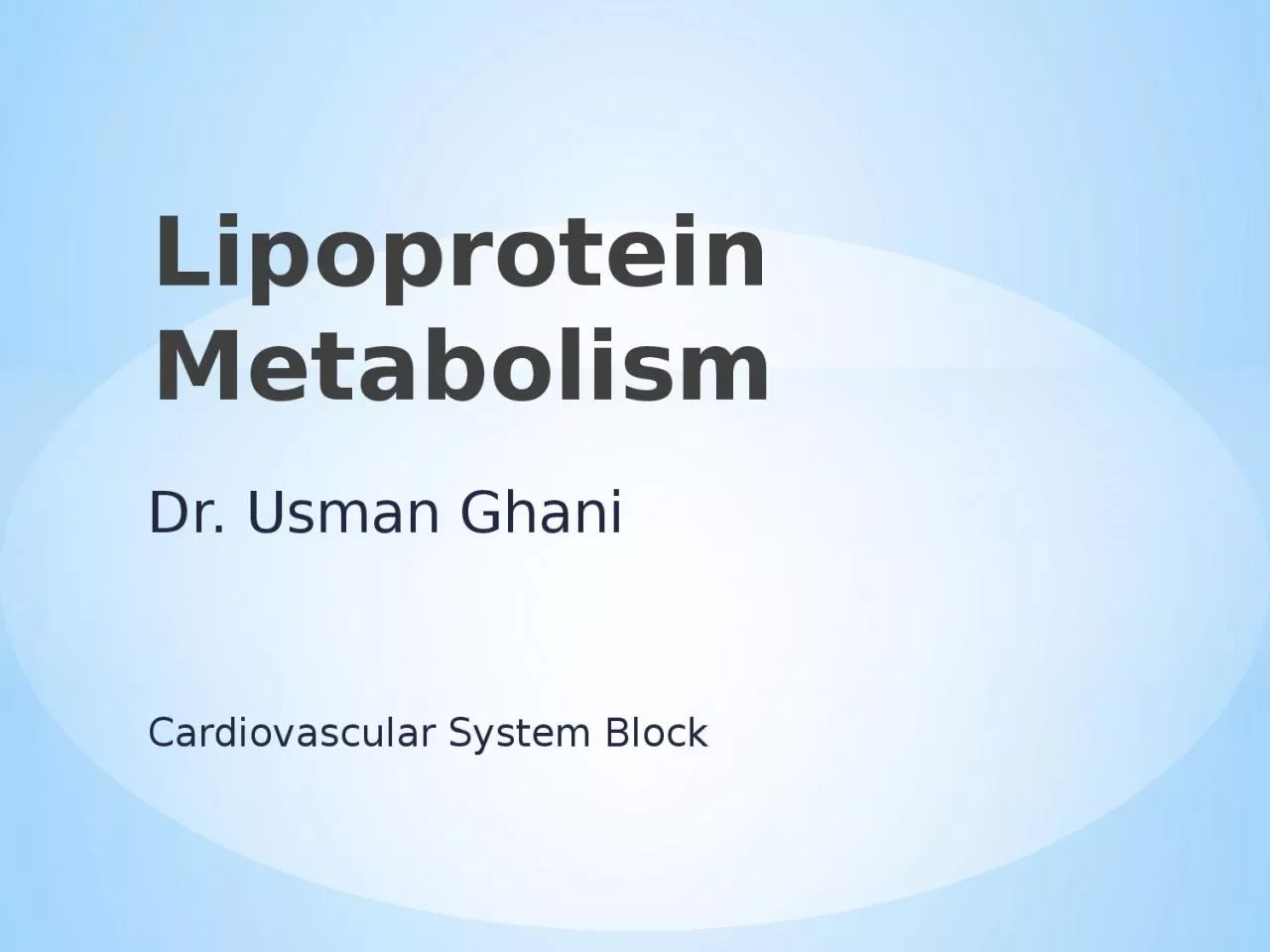

Lipoprotein Metabolism Dr Usman Ghani Objectives By the end of this lecture the First Year students will be able to Define and list the types structure and composition of lipoproteins ID: 1037297
Download Presentation The PPT/PDF document "Cardiovascular System Block" is the property of its rightful owner. Permission is granted to download and print the materials on this web site for personal, non-commercial use only, and to display it on your personal computer provided you do not modify the materials and that you retain all copyright notices contained in the materials. By downloading content from our website, you accept the terms of this agreement.
1. Cardiovascular System BlockLipoprotein MetabolismDr. Usman Ghani
2. ObjectivesBy the end of this lecture, the First Year students will be able to:Define and list the types, structure and composition of lipoproteinsUnderstand various functions of lipoprotein particlesCompare the functions of lipoprotein particles and their implications in diseaseUnderstand the metabolism of chylomicrons, VLDL and LDL particlesDiscuss the functions of lipoprotein lipase and its role in diseaseList the diseases due to imbalance in the metabolism of lipoproteins
3. OverviewLipoprotein types and compositionApolipoproteinsChylomicronsVLDL particles and their metabolismLipoprotein lipaseVLDL diseases
4. LipoproteinsLipids are hydrophobic moleculesTransported in plasma as lipoprotein particlesPlasma lipoproteins are spherical macromolecular complexes of:Lipids andSpecific proteins (apolipoproteins)Lipoproteins keep lipid contents soluble while transporting them to and from the tissues
5. Types of lipoproteinsChylomicrons (lowest density, largest)VLDL (very low density lipoproteins)LDL (low density lipoproteins)HDL (high density lipoproteins)Lipoproteins differ in:Lipid and protein compositionSizeDensitySite of origin
6. Compositions oflipoproteinsNeutral lipid core (hydrophobic):Triacylglycerols (TAGs)Cholesteryl estersHydrophilic shell:Amphipathic apolipoproteinsPhospholipidsFree cholesterol
7. TAGs are mainly transported by:ChylomicronsVLDLCholesterol mainly transported by:LDLHDL
8. ApolipoproteinsTypes:Apo B-48, B-100Apo C-I, C-II, C-IIIApo EFunctions:Provide structure to lipoprotein particlesProvide recognition sites for cell-surface receptorsActivators or coenzymes for the enzymes involved in lipoprotein metabolism
9. ChylomicronsAssembled in the intestinal mucosal cellsTransport to peripheral tissue:Dietary TAGs (90%)CholesterolFat-soluble vitaminsCholesteryl estersThe milky appearance of plasma after a meal is due to chylomicrons
10. VLDLProduced and secreted by the liverComposed of:Mainly endogenous TAGs (60%)Some cholesterol (free and esterified)Carry these lipids from the liver to peripheral tissues
11. VLDLPeripheral tissues degrade TAGs by lipoprotein lipase (LPL) enzymeImbalance in hepatic TAG synthesis and secretion of VLDL can lead to:ObesityType 2 diabetes mellitus
12. VLDL metabolism
13. VLDL metabolism1. Release from the liverAs nascent particles containing:TAGs and cholesterol Apo B-100Obtain apo C-II and apo E from circulating HDL particlesApo C-II is required for activation of LPL
14. VLDL metabolism2. Modification in the circulationTAGs in VLDL are degraded by lipoprotein lipase (LPL)VLDL becomes smaller and denserSurface components (apo C and E) are returned to HDLVLDL transfers TAGs to HDL in exchange for cholesteryl estersThis exchange is catalyzed by cholesteryl ester transfer protein (CETP)
15. VLDL metabolism3. Conversion to LDLAfter modifications, VLDL is converted to:LDLIDL (taken up by liver cells thru apo E)VLDL remnantsApo E exists in three isoforms:Apo E-2 (Poorly binds to receptors)Apo E-3Apo E-4
16. Low density lipoprotein (LDL)Mainly contains cholesterol and cholesteryl estersProduced from VLDL particlesContains Apo B-100 lipoproteinProvides cholesterol to peripheral tissueLDL binds to cell surface receptors thru Apo B-100 (receptor-mediated endocytosis)
17. High density lipoprotein (HDL)Mainly contains:Protein, phospholipids, cholesterol, cholesteryl estersProduced in the liver and intestineContains Apo A-1, C-2 and E lipoproteinsTake up cholesterol from peripheral tissues to the liver
18. Lipoprotein lipase (LPL)Extracellular enzyme that degrades lipidsAnchored by heparin sulfate to the capillary walls of most tissuesMainly present in adipose tissue, cardiac and skeletal muscleRequires apo C-II for activationDegrades TAGs into free fatty acids and glycerolInsulin stimulates LPL synthesisDeficiency of LPL or apo C-II causes:Type 1 hyperlipoproteinemia (familial LPL deficiency)
19. VLDL diseasesHypolipoproteinemiaAbetalipoproteinemia is due to inability to load apo B with lipidsFew VLDLs and chylomicrons are formedTAGs accumulate in liver and intestine
20. VLDL diseasesSteatohepatitis(Fatty liver disease)Imbalance between:TAG synthesis in the liver and Secretion from the liverLeads to accumulation of TAGs in the liver (fatty liver)
21. VLDL diseasesType I hyperlipoproteinemiaA rare, autosomal recessive diseaseDue to familial deficiency of LPL or its coenzyme (apo C-II)Causes excessive accumulation of chylomicrons in plasma (≥1000 mg/dl) (hyperchylomicronemia)High fasting plasma TAGs are observed in these patients
22. VLDL diseasesType III hyperlipoproteinemiaAlso called familial dysbetalipoproteinemia, or broad beta diseaseIndividuals homozygous for apo E-2 are deficient in clearing:Chylomicron remnants andIDL from the circulationLeads to hypercholesterolemia and premature atherosclerosis
23. Take home messageLipoproteins are important for transportation of lipids to and from liver and peripheral tissuesDifferent types of lipoproteins perform different functions in the bodyImbalance in the metabolism of lipoproteins leads to accumulation of lipids in the tissues and circulation increasing the risk for atherosclerosis and coronary heart disease
24. ReferencesLippincott’s Biochemistry. 6th Edition, Chapter 18, pp. 226-232. Lippincott Williams & Wilkins, New York, USA.